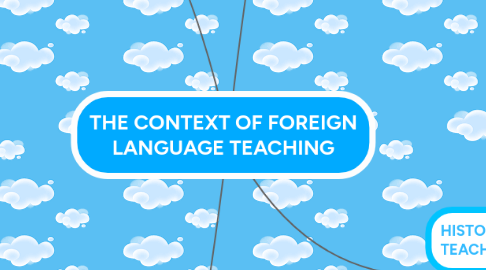
1. APPLIED LINGUISTICS
1.1. Theoretical Linguistics
1.2. Psychology
1.3. Education
1.4. TESOL
1.5. TEFL
1.6. SLA
2. HISTORY OF FOREIGN LANGUAGE TEACHING
2.1. CLASSICAL PERIOD (GRAMMAR TRANSLATION METHOD)
2.1.1. Learning of Greek and Latin
2.1.2. Reading and Writing
2.1.3. Memorization of vocabulary
2.1.4. Grammatical rules
2.1.5. Mother Tongue
2.2. EARLY-MID 20TH CENTURY (REFORMERS)
2.2.1. MARCEL (READING METHOD)
2.2.1.1. Listening to the teacher
2.2.1.2. Putting it into practice
2.2.2. GOUIN (SERIES METHOD)
2.2.2.1. Conversational approach
2.2.2.2. Context
2.2.2.3. Gestures
2.2.3. BERLITZ (DIRECT METHOD)
2.2.3.1. L2 Learning = L1 Learning
2.2.3.2. Everyday vocabulary
2.2.3.3. Oral interaction
2.2.3.4. Spontaneous use of language
2.2.4. PRENDERGAST (THE MASTERY METHOD)
2.2.4.1. Repetition
2.2.4.2. Imitation
2.2.4.3. Mimicry
2.3. AUDIOLINGUAL METHOD (1950's)
2.3.1. Pronunciation
2.3.2. Error-free utterances
2.3.3. Grammar taught inductively
2.3.4. Dialogue
2.3.5. Mimicry
2.4. STRUCTURAL-SITUATIONAL LANGUAGE TEACHING (1960's-1980's)
2.4.1. Pragmatic version of ALM
2.4.2. Techniques of ALM + Situation
2.4.3. Speaking & Listening
2.4.4. PPP (Presentation, Practice, Production)
2.5. DESIGNER METHODS (1970's-1980's)
2.5.1. Relaxation
2.5.2. Music
2.6. THE SILENT WAY
2.6.1. Discovering & Creating > Repeating & Imitating
2.6.2. Problem solving
2.7. COMMUNITY LANGUAGE TEACHING
2.7.1. Learners as a group
2.7.2. Interpersonal communication
2.7.3. Linked to bilingual education
2.8. TOTAL PHYSICAL RESPONSE
2.8.1. Physical motor activity
2.8.2. Adult L2 Learning = Child L1 Learning
2.9. COMMUNICATIVE LANGUAGE TEACHING
2.9.1. Authentic communication
2.9.2. Fluency
2.9.3. Trial & Error
3. INTELLIGENCES THEORIES IN LANGUAGE LEARNING
3.1. LANGUAGE APTITUDE
3.1.1. Auditory ability (input)
3.1.2. Linguistic ability (central processing)
3.1.3. Memory ability (output)
3.2. EXCEPTIONAL LEARNERS
3.2.1. Unusual memory
3.2.2. Good input skills
3.2.3. Cognition + Emotion
3.3. SUCCESSFUL INTELLIGENCE
3.3.1. ANALYTICAL INTELLIGENCE
3.3.1.1. Compare & Contrast
3.3.1.2. Evaluate
3.3.1.3. Explain
3.3.1.4. Judge
3.3.1.5. Criticize
3.3.2. CREATIVE INTELLIGENCE
3.3.2.1. Create
3.3.2.2. Design
3.3.2.3. Invent
3.3.2.4. Imagine
3.3.2.5. Suppose
3.3.3. PRACTICAL INTELLIGENCE
3.3.3.1. Use
3.3.3.2. Apply
3.3.3.3. Implement
3.3.3.4. Employ
3.3.3.5. Contextualize
3.4. PROJECT-BASED LEARNING
3.4.1. Solve a problem
3.4.2. Work together
3.4.3. Real-life projects
3.4.4. Production
3.5. MULTIPLE INTELLIGENCES
3.5.1. Musical
3.5.2. Linguistic
3.5.3. Spatial
3.5.4. Naturalist
3.5.5. Bodily-Kinesthetic
3.5.6. Interpersonal
3.5.7. Intrapersonal
3.5.8. Logical-Mathematical
4. THE TASK-BASED APPROACH IN LANGUAGE LEARNING
4.1. TASK-BASED LEARNING
4.1.1. Focus on meaning
4.1.2. Communication
4.1.3. Use of content to build language skills
4.1.4. Goal
4.1.5. Real-life situations
4.2. TASK STRUCTURE
4.2.1. Pre-Task
4.2.2. Task
4.2.3. Post-Task
4.3. TASK TYPES
4.3.1. One way/Two Way
4.3.2. Open/Closed
4.4. CLIL
4.4.1. CONTENT BENEFITS
4.4.1.1. Dynamic
4.4.1.2. Creative thinking
4.4.2. LANGUAGE BENEFITS
4.4.2.1. Quality & Quantity of Input & Output
4.4.2.2. Interaction
4.4.2.3. Incidental Language Learning
4.4.3. EDUCATION BENEFITS
4.4.3.1. Curricular approach
4.4.3.2. Learning processes emphasized
4.4.3.3. Intrinsic motivation
4.4.4. SOCIAL BENEFITS
4.4.4.1. Plurilingual & Pluricultural approach
4.4.5. IMMERSION
